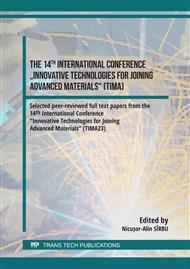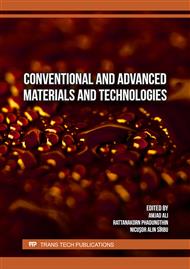[1]
https://color-metal.ro/ro/categorii, Color Metal
Google Scholar
[2]
I. Bordeasu: Monografia Laboratorului de Cercetare a Eroziunii Prin Cavitatie al Universitatii Politehnica Timisoara (1960–2020); Editura Politehnica Timisoara, Romania, ISBN 978-606-35-0371-9, Timisoara (2020)
DOI: 10.31924/nrsd.v13i2.143
Google Scholar
[3]
*** ASTM, Standard G32; Standard Method of Vibratory Cavitation Erosion Test. ASTM: West Conshohocken, PE, USA, (2016)
Google Scholar
[4]
I. Mitelea: Materiale inginereşti, Editura Politehnica, Timişoara, Romania, (2009)
Google Scholar
[5]
I. Bordeasu, C. Ghera, D. Istrate, L. Salcianu, B. Ghiban, D. Bazavan, L.M. Micu L, D.C. Stroita, A. Suta, I. Tomoiaga, A.N. Luca: Resistance and Behavior to Cavitation Erosion of Semi-Finished Aluminum Alloy 5083, "HIDRAULICA" (No. 4/2021), pp.17-24
DOI: 10.3390/cryst12111538
Google Scholar
[6]
I. Bordeaşu: Cavitation erosion on materials used in the construction of hydraulic machines and naval propellers. Scale effects (in Romanian:Eroziunea cavitaţională asupra materialelor utilizate în construcţia maşinilor hidraulice şi elicelor navale. Efecte de scară), PhD Thesis, Timişoara, (1997)
Google Scholar
[7]
O. Oanca: Tehnici de optimizare a rezistenţei la eroziunea prin cavitaţie a unor aliaje CuAlNiFeMn destinate execuţiei elicelor navale, Teza de doctorat, Timișoara (2014)
Google Scholar
[8]
D. Istrate, B.G. Sbârcea, A.M. Demian, A.D. Buzatu, L. Salcianu, I. Bordeasu, L. M. Micu, C. Ghera, B. Florea and B. Ghiban Correlation between Mechanical Properties—Structural Characteristics and Cavitation Resistance of Cast Aluminum Alloy Type 5083, Crystals (2022)
DOI: 10.3390/cryst12111538
Google Scholar
[9]
I. Bordeasu, M.O. Popoviciu, I. Mitelea, V. Balasoiu, B. Ghiban, D. Tucu: Chemical and mechanical aspects of the cavitation phenomena, Rev. Chim., Volume 58, Issue 12, pp.1300-1304 (2007)
Google Scholar
[10]
I. Bordeasu, I. Mitelea, L. Salcianu, C.M. Craciunescu: Cavitation Erosion Mechanisms of Solution Treated X5CrNi18-10 Stainless Steels, Journal of Tribology-Transactions of the Asme, vo. 138, no. 3, Article Number 031102, (2016)
DOI: 10.1115/1.4032489
Google Scholar
[11]
L.M. Micu, I. Bordeasu, M.O. Popoviciu: A New Model for the Equation Describing the Cavitation Mean Depth Erosion Rate Curve, Rev. Chim. (Bucharest), 68, no. 4, pp.894-898, (2017)
DOI: 10.37358/rc.17.4.5573
Google Scholar
[12]
I. Anton: Cavitatia, Vol I, Editura Academiei RSR, Bucuresti, (1984)
Google Scholar
[13]
R. Garcia, F.G. Hammitt, R.E. Nystrom: Corelation of cavitation damage with other material and fluid properties, Erosion by Cavitation or Impingement, ASTM, STP 408 Atlantic City, ((1960)
DOI: 10.1520/stp46052s
Google Scholar
[14]
I. Mitelea, I. Bordeasu, E. Riemschneider, I.D Utu, C.M Craciunescu: Cavitation erosion improvement following TIG surface-remelting of gray cast iron, Wear, p.496–497, 204282, (2022)
DOI: 10.1016/j.wear.2022.204282
Google Scholar
[15]
D. Bordeasu; O. Prostean, C. Hatiegan: Contributions to Modeling, Simulation and Controlling of a Pumping System Powered by a Wind Energy Conversion System, Energies, Vol. 14, No.22, 7696, (2021)
DOI: 10.3390/en14227696
Google Scholar
[16]
D. Bordeasu, O. Prostean, I. Filip, F. Dragan, C. Vasar: Modelling, Simulation and Controlling of a Multi-Pump System with Water Storage Powered by a Fluctuating and Intermittent Power Source, Mathematics, Vol. 10, no.21, 4019, (2022)
DOI: 10.3390/math10214019
Google Scholar
[17]
D. Bordeasu; O. Prostean, I. Filip, F. Dragan, C. Vasar: Adaptive Control Strategy for a Pumping System Using a Variable Frequency Drive, Machines, Vol.11, No.7, DOI: 10.3390/machines11070688, (2023)
DOI: 10.3390/machines11070688
Google Scholar
[18]
D. Bordeasu: Study on the Implementation of an Alternative Solution to the Current Irrigation System, Acta Tech. Napoc. Ser.-Appl. Math. Mech. Eng. vol.65, no.3, pp.593-602, (2022)
Google Scholar
[19]
L.M Micu, I. Bordeasu, M.O. Popoviciu, M. Popescu, D. Bordeasu, L.C Salcianu: Influence of volumic heat treatments upon cavitation erosion resistance of duplex X2CrNiMoN 22-5-3 stainless steels, IOP International Conference on Applied Sciences 2014 (ICAS2014), vol.85, 012019, (2015)
DOI: 10.1088/1757-899x/85/1/012019
Google Scholar
[20]
N. Tian, G. Wang, Y, Zhou, K. Liu, G. Zhao, L. Zuo: Study of the Portevin-Le Chatelier (PLC) Characteristics of a 5083 Aluminum Alloy Sheet in Two Heat Treatment States, States Mater. Vol. 11, 1533, (2018)
DOI: 10.3390/ma11091533
Google Scholar
[21]
H.C. Man, C.T. Kwok, T.M. Yue: Cavitation erosion and corrosion behaviour of laser surface alloyed MMC of SiC and Si3N4 on Al alloy AA6061. Surf. Coat. Technol. Vol. 132, p.11–20, (2000).
DOI: 10.1016/s0257-8972(00)00729-5
Google Scholar
[22]
W.J. Tomlinson, S.J. Matthews: Cavitation erosion of aluminium alloys. J. Mater. Sci., vol.29, p.1101–1108, (1994)
Google Scholar
[23]
N.I. Kolobnev, L.B. Khokhlatova, D.K. Ryabov: Structure, properties and application of alloys of the Al-Mg-Si-(Cu) system, Met. Sci. Heat. Treat., vol.53, p.440–444, (2012)
DOI: 10.1007/s11041-012-9412-8
Google Scholar
[24]
F. Xigang, J. Damin, Z. Li, W. Tao, R. Shiyu: Influence of microstructure on the crack propagation and corrosion resistance of Al–Zn–Mg–Cu alloy 7150. Mater. Charact., vol.58, p.24–28, (2007)
DOI: 10.1016/j.matchar.2006.03.003
Google Scholar
[25]
I. Bordeasu, M.O. Popoviciu, L.M. Micu, O.V. Oanca, D. Bordeasu, A. Pugna, C. Bordeasu, Laser beam treatment effect on AMPCO M4 bronze cavitation erosion resistance. IOP Conf. Ser. Mater. Sci. Eng, vol.85, 012005, (2015)
DOI: 10.1088/1757-899x/85/1/012005
Google Scholar
[26]
I. Bordeasu, M.O. Popoviciu, C. Patrascoiu, V. Balasoiu: An Analytical Model for the Cavitation Erosion Characteristic Curves Sci. Bul. Politeh. Univ. Timis. Trans. Mech. vol.49, p.253–258, (2004)
Google Scholar



